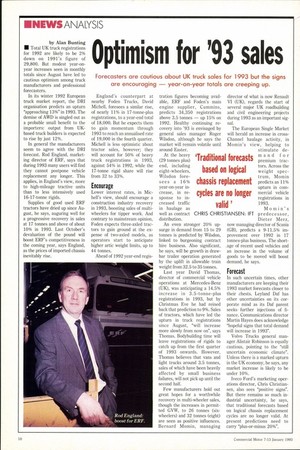Optimism for '93 sales Forecasters are cautious about UK truck
Page 12

If you've noticed an error in this article please click here to report it so we can fix it.
sales for 1993 but the signs are encouraging — year-on-year totals are creeping up. by Alan Bunting • Total UK truck registrations for 1992 are likely to be 2% down on 1991's figure of 29,800. But modest year-onyear increases seen in monthly totals since August have led to cautious optimism among truck manufacturers and professional forecasters.
In its winter 1992 European truck market report, the DRI organisation predicts an upturn "approaching 13%" in 1993. The demise of AWD is singled out as a probable small benefit to the importers: output from UKbased truck builders is expected to rise by just 12%.
In general the manufacturers seem to agree with the DRI forecast. Rod England, marketing director of ERF, says that during 1993 many users will find they cannot postpone vehicle replacement any longer. This applies, in England's view, more to high-mileage tractive units than to less intensively used 16-17-tonne rigids.
Supplies of good used ERF tractors have dried up since August, he says, auguring well for a progressive recovery in sales at 17 tonnes and above of about 10% in 1993. Last October's devaluation of the pound will boost ERF's competitiveness in the coming year, says England, as the prices of imported chassis inevitably rise. England's counterpart at nearby Foden Trucks, David Michell, foresees a similar rise, of nearly 11% in 17-tonne-plus registrations, to a year-end total of 18,000. But he expects them to gain momentum through 1993 to reach an annualised rate of 19,000 in the fourth quarter. Michell is less optimistic about tractor sales, however; they will account for 50% of heavy truck registrations in 1993, against 54% in 1992, while the 17-tonne rigid share will rise from 32 to 33%.
Encourage Lower interest rates, in Michell's view, should encourage a construction industry recovery in 1993, boosting sales of multiwheelers for tipper work. And contrary to mainstream opinion, Foden expects three-wded tractors to gain ground at the expense of two-axled models, as operators start to anticipate higher artic weight limits, up to 44 tonnes.
Ahead of 1992 year-end regis tration figures becoming available, ERF and Foden's main engine supplier, Cummins, predicts 34,350 registrations above 3.5 tonnes — up 15% on 1992. Healthy continuing recovery into '93 is envisaged by general sales manager Roger Wilsdon, although he says the market will remain volatile until around Easter.
At the heavy (29 tonnes plus) end, including eight-wheelers, Wilsdon foresees a 16% year-on-year increase, in response to increased traffic in haulage as well as contract distribution.
An even stronger 20% upsurge in demand from 15 to 29 tonnes is predicted by Wilsdon, linked to burgeoning contract hire business. Also significant, he says, will be growth in drawbar trailer operation generated by the uplift in allowable train weight from 32.5 to 35 tonnes.
Last year David Thomas, director of commercial vehicle operations at Mercedes-Benz (UK), was anticipating a 14.5% increase in 3.5-tonne-plus registrations in 1993, but by Christmas Eve he had reined back that prediction to 9%. Sales of tractors, which have led the upturn in truck registrations since August, "will increase more slowly from now on", says Thomas. Bodybuilding time will leave registrations of rigids to catch up from the first quarter of 1993 onwards. However, Thomas believes that vans and light trucks around 3.5 tonnes, sales of which have been heavily affected by small business failures, will not pick up until the second half.
Few manufacturers hold out great hopes for a worthwhile recovery in multi-wheeler sales, though the increases in permitted GVW, to 26 tonnes (sixwheelers) and 32 tonnes (eight) are seen as positive influences. Bernard Momin, managing director of what is now Renault VI (UK), regards the start of several major UK roadbuilding and civil engineering projects during 1993 as an important signal.
Momin's predecessor, Dieter Merz, now managing director of Scania (GB), predicts a 9-11.5% improvement over 1992 in 17 tonnes-plus business. The shortage of recent used vehicles and an increase in the volume of goods to be moved will boost demand, he says.
Forecast In such uncertain times, other manufacturers are keeping their 1993 market forecasts closer to their chests. Leyland Daf has other uncertainties on its corporate mind as its Daf parent seeks further injections of finance. Communications director Martin Hayes does acknowledge "hopeful signs that total demand will increase in 1993".
Volvo Trucks general manager Alistair Robinson is equally cautious, pointing to the "still uncertain economic climate". Unless there is a marked upturn in the UK economy, he says, any market increase is likely to be under 10%.
Iveco Ford's marketing operations director, Chris Christiansen, also sees "positive signs". But there remains so much industrial uncertainty, he says, that traditional forecasts based on logical chassis replacement cycles are no longer valid. At present predictions need to carry "plus-or-minus 20%".




























































